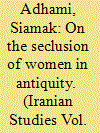| Srl | Item |
| 1 |
ID:
186912


|
|
|
|
|
| Summary/Abstract |
Despite the impressive research of scholars on Middle Persian grammatical problems, there are still many words in surviving texts that are shrouded in ambiguity. One of these words, whose pronunciation in the inscriptions we owe to the Manichaean texts, is dastan. In this article, first the few available instances of this word in Middle Persian inscriptions and Manichaean texts are mentioned, and scholars’ interpretations of its meaning and grammatical category are discussed. Then it is revisited through the analysis of another word, tuwān, with which it is paired in the Manichaean instance. After a review of prior scholarly interpretations of this latter word, it is argued that in Middle Persian tuwān is a noun, and that it became a modal verb during the process of its application to the possessive structure. Finally, it is asserted that dastan also is a noun, due to its conjoinment with tuwān in the Manichaean example.
|
|
|
|
|
|
|
|
|
|
|
|
|
|
|
|
| 2 |
ID:
068882


|
|
|
| 3 |
ID:
144717


|
|
|
|
|
| Summary/Abstract |
Summary: The study of the feminine in ancient Iran is an area which deserves much greater attention than it has thus far received. By utilizing a number of primary sources, textual and otherwise, a few observations are offered here which concern the rites of women through the centuries. These evolving rites, which are described by the doctors of the then-dominant religion of Zarathustra, deal with the preservation of purity through seclusion of women in a world which is under constant attack from the demonic, polluting forces. Throughout the essay, the different means of fighting this battle are explored and suggestions for further research in the field are made.
|
|
|
|
|
|
|
|
|
|
|
|
|
|
|
|